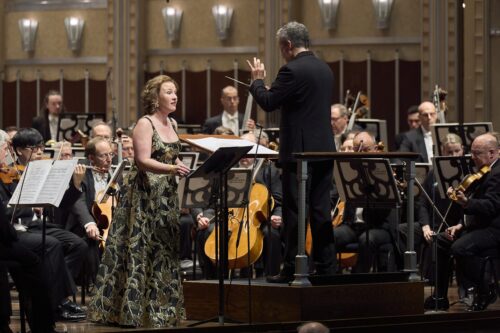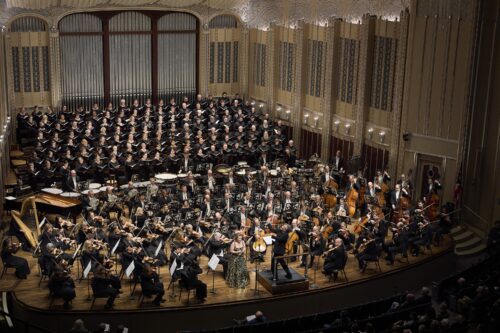 United States Adès Conducts Adès: Sasha Cooke (soprano), Cleveland Orchestra Chorus / Lisa Wong (director), Cleveland Orchestra / Thomas Adès (conductor). Mandel Concert Hall at Severance Music Center, Cleveland, 20.2.2025. (MSJ)
United States Adès Conducts Adès: Sasha Cooke (soprano), Cleveland Orchestra Chorus / Lisa Wong (director), Cleveland Orchestra / Thomas Adès (conductor). Mandel Concert Hall at Severance Music Center, Cleveland, 20.2.2025. (MSJ)

Sibelius – The Oceanides, Op.73
Ives – Orchestral Set No.2
Saariaho – Oltra Mar
Adès – America: A Prophecy
Making major changes to musical works years, even decades, after the piece was written is a risky prospect. Twenty-five years is a long time, and issues of style can strangely skew reworked pieces. But an artist should always be allowed the option to redo things as part of the creative arsenal. I will admit, however, that I had some doubts when I heard that British composer Thomas Adès was adding a new movement to his wrenching America: A Prophecy.
The piece sets Mayan prophetic texts about the coming fiery destruction of their civilization by invaders from the east, who turned out to be the Spanish conquistadors. The piece originally ended crushingly with the chorus reciting a Latin prayer while the soprano soloist keens a stark benediction to the holocaust: ‘Weep, weep, weep, but know this well: Ash feels no pain’.
It stings. It is a tough ending, an uncompromising ending fit for the destruction of one of the world’s great civilizations. When I heard that Adès later expressed discomfort with it and wanted to add to the piece to offer some element of hope, it felt on the surface like a concession to conventionality, softening the blow. I certainly went into this concert, the US premiere of the revised version, prepared to be disappointed by a softened ending.
It turns out, I needn’t have worried. If there is an element of hope with the new third movement, it is only in the grand vision of the world going on: ‘In every birth a death / In every death a birth / This is the story of the world’. What Adès has done in his revision is not to soften the sting, but rather to give it a formal eulogy/elegy that fits seamlessly with the original two movements in one long, devastating gesture.

Most remarkable of all was the simple but unprecedented gesture of having the closing choral line be a note that starts high in the sopranos, slowly slides downward into the altos, on to the tenors and down into the basses before it sinks into the depths of orchestral sound at the bottom. A simple idea, yes, but an extraordinarily difficult one to perform seamlessly with a large chorus. Lisa Wong’s Cleveland Orchestra Chorus made it both dignified and gut-wrenching.
Soprano Sasha Cooke was intense, powerful and penetrating as she gave haunting voice to these ancient texts, using the genius of Adès’s music to bring the listener into the soul of the moment. The performance and piece were triumphs and brought the audience to its feet for repeated curtain calls.
And that piece was merely the climax of a powerfully programmed evening, which gave Adès a chance to demonstrate his wider interests. The Cleveland Orchestra has a long history of working with composer-conductors, including notable relationships with Igor Stravinsky and Pierre Boulez. While there have been composer-conductors who were well-established as professional conductors, many of them were more focused on their writing and only took up conducting as a way to help promote their own works. These ‘default’ conductors can vary in skill, with historical stories running rife about the ineffectiveness of some of them – such as Debussy and Ravel – who were both rated as mediocre conductors. Even Stravinsky and Copland were mainly appreciated in their own works.
Thomas Adès certainly does not display the technical polish of a highly-trained conductor, and he has erratic and unpredictable movements. But what was clear from his enthusiastic cueing of details was that he knew the pieces down to the finest details, and if his movements were unconventional, they were nonetheless highly expressive. The Cleveland Orchestra is just the kind of orchestra that can realize an expressive vision whether they are given conventional time-beating or not.
The Oceanides, Sibelius’s Mediterranean seascape, emerged with dazzling glints of colors and just the right touch of Baltic steel in the brass toward the end. Ives’s rarely heard Orchestral Set No.2 was stunning, Adès captured both the swing of the popular-music-influenced passages and the uncanny visionary element of Ives’s conflicting layers, all played gloriously by the orchestra, including offstage players and chorus in the third movement.
Kaija Saariaho’s Oltra Mar (Across the Sea) was originally premiered at the same concert as America: A Prophecy, and Adès wanted to bring the two works together again here. They work well together, though they make for a demandingly intense concert half. Oltra Mar is an impressive, colorful work, though I did find myself thinking that alongside the revised Adès piece, it comes across as a little too declamatory and, arguably, is a little long for its substance, running about thirty minutes over seven movements.
The odd-numbered movements of Oltra Mar feature a wordless chorus, while the even-numbered movements set texts by Abu Sa’id, Amin Maalouf and a traditional African death song. The text-driven numbers do seem more focused, while the wordless ones don’t necessarily justify their length, particularly the very first, which started as sternly declamatory and then hardly went anywhere else for minutes. The bulk of the work, though, was powerful, moving and full of interesting textures, all brought off vividly by singers and players.
In short, both the general concert and, specifically, the Adès rewrite, co-commissioned by the Cleveland Orchestra, were major successes. Cleveland has had a strong connection with Thomas Adès ever since then-music-director Christoph von Dohnànyi championed the composer’s breakthrough composition, Asyla, in the 1990s. That relationship is poised to continue.
Mark Sebastian Jordan
